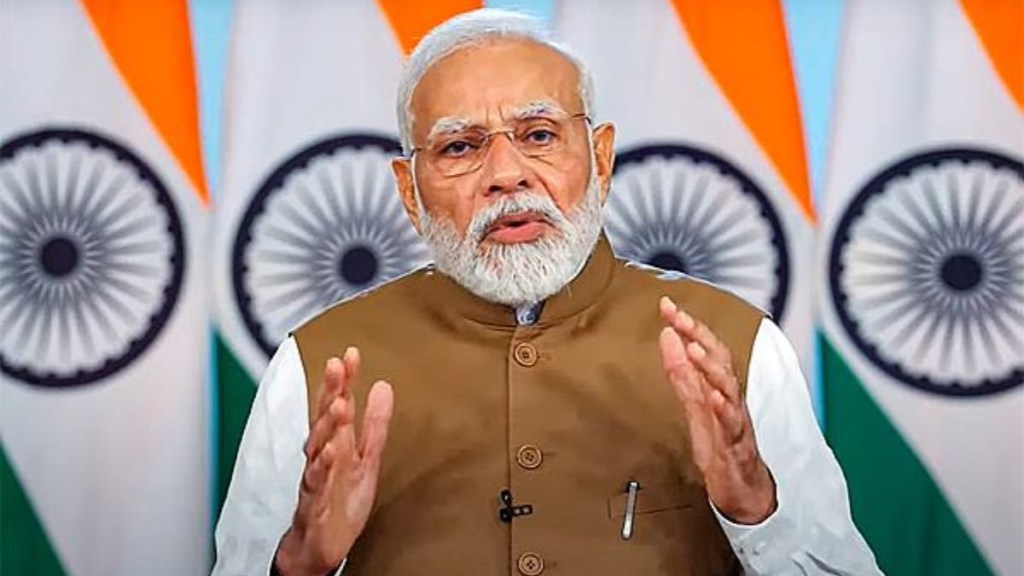Ahead of a very important test flight scheduled for October 21, which marks India’s inaugural manned space mission, Prime Minister Narendra Modi has unveiled a pair of ambitious objectives. These goals include the establishment of an Indian space station, known as ‘Bharatiya Antariksha Station,’ by 2035, and a manned mission to the Moon by 2040. This significant announcement was officially conveyed by the Prime Minister’s Office (PMO) and underscores India’s unwavering commitment to space exploration.
The announcement came as a result of a comprehensive assessment of preparations for the Gaganyaan mission, India’s maiden human spaceflight venture, set to be executed in 2025. The evaluation took place on October 17, and the meeting was chaired by Prime Minister Modi himself. The Department of Space (DoS), responsible for overseeing the Indian Space Research Organisation (ISRO), presented an overview of the progress and the advanced technologies developed for the Gaganyaan mission.
The DoS is now tasked with devising a roadmap for lunar exploration, encompassing a sequence of Chandrayaan missions, the development of a new generation launch vehicle, construction of a fresh launch facility, and the establishment of human-centric laboratories alongside the associated technologies, as disclosed in the PMO statement.
Prime Minister Modi also issued a call to action, urging scientists to channel their expertise towards interplanetary endeavours. This encompasses the development of a space vehicle designed to orbit Venus and another engineered for a controlled landing on Mars.
Space Station
This ambitious space agenda comes with a significant price tag. Unlike the earlier space stations and moon missions undertaken by the United States and Russia, which were outcomes of military space races, contemporary space stations require a different approach, entailing extensive testing and consequently incurring high costs, according to experts.
The International Space Station (ISS), a collaborative project involving the United States, Russia, Canada, Japan, and European space agencies, currently serves as the world’s largest space station. However, it is projected to be decommissioned by 2030 due to mounting operational costs and disagreements among partner nations regarding financial contributions. China’s Tiangong, a comparatively smaller space station, is the only other operational station, hosting a three-person crew. Since India’s involvement with the Artemis Accords, a US-led initiative aimed at returning to the Moon, plans are in motion to send an Indian astronaut to the ISS in 2024.
Budget for Space Missions
To realize the ambitions of a manned mission to the Moon and the construction of a space station, India will need to make substantial and sustained investments, with significant participation from the private sector. The DoS, has been instructed to craft a blueprint for India’s forthcoming lunar missions, the development of a Next Generation Launch Vehicle (NGLV) capable of conducting return missions, the construction of a new launch facility, and the establishment of human-centric laboratories and associated technologies.
During the meeting, the Prime Minister further implored Indian scientists to focus on interplanetary initiatives, including a mission to orbit Venus and a mission to execute a controlled landing on Mars.
An extensive evaluation of the Gaganyaan Mission was also conducted during the meeting. This review encompassed various technologies developed so far, such as human-rated launch vehicles and system qualification. The deliberations highlighted the planned execution of approximately 20 major tests, including three uncrewed missions involving the Human Rated Launch Vehicle (HLVM3).
Test Vehicle Development Flight (TV-D1)
Is scheduled for takeoff at 8 AM on Tuesday from the Satish Dhawan Space Centre in Sriharikota. The mission’s visibility from the launch view gallery will be limited. The Gaganyaan project signifies India’s capability to dispatch manned space missions and involves launching a three-person crew into an orbit situated 400 kilometers above Earth’s surface, on a three-day mission.
The prerequisites for the Gaganyaan mission involve the development of several critical technologies. These include a human-rated launch vehicle designed to ensure the safe conveyance of the crew to space, a life support system capable of creating an Earth-like environment for the crew in space, provisions for crew emergency escape, and the evolution of crew management aspects encompassing training, recovery, and crew rehabilitation, as articulated in ISRO’s mission document.
In addition to fulfilling these essential prerequisites, the mission is also slated to serve as a demonstration of technological readiness before the final human spaceflight mission is undertaken. The demonstrator missions entail integrated air drop tests (IADT), pad abort tests (PAT), and test vehicle (TV) flights.
The TV-D1 test vehicle represents a single-stage liquid rocket devised for this abort mission. It will carry payloads such as the Crew Module (CM) and Crew Escape Systems (CES), equipped with fast-acting solid motors, along with the CM fairing (CMF) and Interface Adapters.
According to ISRO, the flight will replicate the conditions encountered during an ascent trajectory corresponding to a Mach number of 1.2, a scenario anticipated during the Gaganyaan mission. At an altitude of approximately 17 kilometers, the CES will separate from the test vehicle, initiating the autonomous execution of the abort sequence. This sequence will include the separation of CES, parachute deployment, and culminate in the safe landing of the CM in the sea, situated roughly 10 kilometers from the Sriharikota coast, as detailed by the space agency.
In light of today’s announcement by Prime Minister Modi regarding the establishment of an Indian Space Station by 2035 and the dispatch of the first Indian astronaut to the Moon by 2040, Lt Gen AK Bhatt (Retd.), Director General of ISpA, conveyed his perspective on the development. He stated, “Today’s announcement of timelines by the Prime Minister will solidify India’s commitment to usher in new possibilities for our nation in the realm of space and stimulate innovation in this pioneering journey.”
Furthermore, he emphasized the potential of these initiatives to engage India’s private space sector and fuel advancements in the nation’s space endeavors. The establishment of clear objectives for the creation of a space station by 2035 and the lunar landing mission by 2040 provides a focused trajectory for India’s burgeoning space enterprise.

